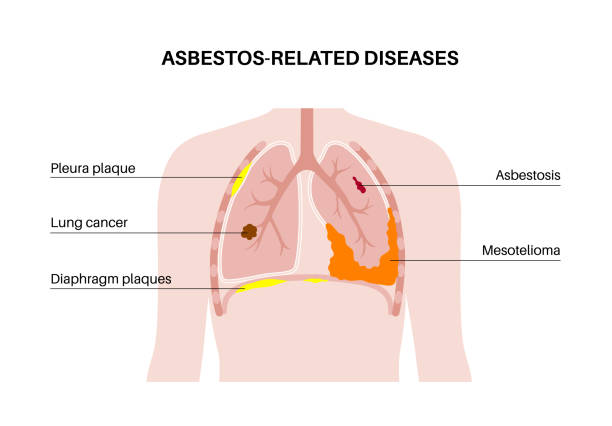Recognizing these warning signals promptly is vital to seek medical evaluation, as asbestos-related illnesses can progress silently. Understanding these initial symptoms helps individuals take immediate action, potentially improving health outcomes.
Early Signs Of Asbestos Poisoning

Asbestos poisoning, more commonly referred to as asbestos-related diseases, can manifest through several early signs, often related to respiratory issues.
Inhaling asbestos fibers can lead to serious conditions such as asbestosis, lung cancer, and malignant mesothelioma.
Here are the early signs of asbestos exposure based on medical consensus and trusted health sources:
- Shortness of Breath: The most common early symptom, resulting from asbestos fibers causing scarred lung tissue, which restricts breathing.
- Persistent Cough: A dry cough that does not go away over time might be an initial indicator of asbestos fiber irritation or lung tissue damage.
- Chest Tightness or Pain: This can occur due to inflammation or damage to lung tissues caused by asbestos fibers.
- Crackling Sound When Breathing: This symptom, heard through a stethoscope, indicates lung scarring and is often associated with asbestosis.
These symptoms can develop after a long latency period – often decades after exposure.
If someone experiences these symptoms and has a history of prolonged exposure it is crucial to seek medical advice for early diagnosis and management.
How Much Asbestos Exposure Causes Cancer

The relationship between asbestos exposure and cancer is complex and influenced by several factors:
- No Safe Exposure Level: Health organizations like the World Health Organization (WHO) and the U.S. Environmental Protection Agency (EPA) agree that no level of asbestos exposure is safe. Even small amounts of asbestos fibers can lead to health risks.
- Cumulative Exposure: The risk of developing cancer increases with cumulative exposure over time. People exposed to higher concentrations or over extended periods have a higher risk.
- Latency Period: Asbestos-related cancers, such as lung cancer and mesothelioma, can take decades to develop, often appearing 20-50 years after initial exposure.
- Type of Asbestos Fiber: Different types of asbestos fibers carry varying levels of carcinogenicity. Amphibole asbestos (e.g., crocidolite) is generally considered more hazardous than chrysotile asbestos.
- Other Risk Factors: Smoking significantly increases the risk of lung cancer when combined with asbestos exposure.
- Occupational and Environmental Risks: Those working in industries with heavy asbestos use, like construction and shipbuilding, or living near asbestos mines or contaminated buildings, have an elevated risk.
These facts underscore the importance of minimizing or eliminating exposure to asbestos in all settings.
Effects Of Asbestos Exposure On Other Parts Of The Body

Asbestos exposure primarily impacts the lungs and respiratory system, but it can also affect other body parts.
Here are the known effects of asbestos exposure on different organs and systems based on established health data:
- Digestive System: Ingestion of asbestos fibers, often through contaminated food, water, or mucus cleared from the respiratory tract, can increase the risk of cancers of the gastrointestinal system, including the esophagus, stomach, and colon.
- Heart: A pericardial mesothelioma is a rare form of cancer affecting the pericardium (the lining around the heart). While uncommon, it is strongly linked to asbestos exposure.
- Immune System: Asbestos fibers can trigger immune responses leading to inflammation and fibrous tissue formation, which may compromise the immune system and increase vulnerability to infections.
- Kidneys: Exposure to asbestos fibers has been linked to an elevated risk of kidney cancer, though the exact mechanism is still under investigation.

